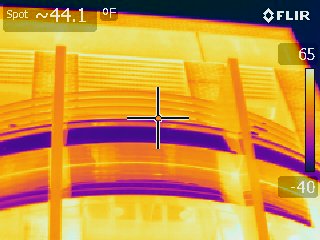IECC Air Barrier Verification and Testing

The building enclosure plays an important role in a building’s energy consumption. Historically, weather barrier detailing has focused on watertightness over airtightness, choosing to prevent water intrusion due to the immediate impact it can have on a property’s operation. However, this has exposed shortcomings in how the industry designs and constructs building enclosures for performance and sustainability.
With a trend toward constructing more energy-efficient buildings, the 2021 International Energy Conservation Code (IECC) requires air barrier performance to be validated in one of two ways:
- Verification: Verification includes design reviews in concert with site observations to check that the design and construction meet the code requirements.
- Field testing: Testing quantifies air leakage through the building enclosure, and allows for a comparison to industry standards.
Both compliance options can provide useful information relating to long-term building performance. However, the timely selection of which path to take can make the difference in whether a project meets budgetary and schedule constraints.
Do These Provisions Apply to My Project?
The requirement to verify or test air barrier assemblies applies to all commercial projects governed by the 2021 IECC, including new and existing buildings. In fact, some jurisdictions have amended their local energy code to expand upon these provisions, including requiring both verification and testing (which is the case in Denver, Colorado) or establishing more stringent testing criteria (like in Washington state). The enclosure section of the Commercial IECC (C402) is catching up to longstanding commissioning requirements of the mechanical section (C403), with the understanding that improvements to HVAC system efficiency cannot be fully realized unless the building enclosure is reasonably airtight.

Air barrier requirements in the energy code are critical to the continued improvement of energy performance in buildings and are becoming more stringent with each code iteration.
Which Approach Should I Choose?
Choosing to test the air barrier may seem like the most efficient approach, but it leaves the project open to potential delays and added costs if the test results exceed the allowable air leakage rate. Testing generally must be conducted at the end of the construction phase when any conditions causing excess air leakage are typically concealed behind interior and exterior finish materials. This makes repairs to address air leakage challenging at a time when cost and schedule overruns are difficult for a project to absorb.
On the other hand, the verification approach is a prescriptive compliance path and, if performed in accordance with IECC requirements, will alleviate any guesswork from the process. Additionally, the design review and site observations can often provide valuable insights into other building enclosure-related issues, including water infiltration, material durability, thermal bridging, condensation potential, and constructability issues. Many projects will choose to include a building enclosure design review and site observations as part of the overall QA/QC program, regardless of code requirement, which can subsidize the cost of these activities. However, to implement the verification compliance path, the team must identify the need for this requirement during the design phase and prior to any direction from the AHJ.

What’s Next?
While air barrier verification is less risky for a project due to its prescriptive nature, its implementation depends on early engagement during the design phase, which is challenging when project teams have not previously been exposed to these new requirements. If the window to perform verification has passed, testing might be the only option for energy code compliance. Depending on the size and occupancy type of the building, testing can sometimes be conducted in one day or less, which could decrease the costs associated with air barrier compliance. However, the risk of failing the test increases without prior involvement from an air barrier professional.
Air barrier requirements in the energy code are critical to the continued improvement of energy performance in buildings and are becoming more stringent with each code iteration. As the industry continues to acclimate to these provisions, our best defense against negative project outcomes will be continued education to allow for proactive steps to meet these requirements.

